C. Nyal de Kaye
New member
We have been out of action for over two years due to my wife's ill-health. After two operations and twelve trips to hospital the doctors declared that she was well enough to go away again: hooray! So we hooked up the off-road van and away we went. My wife's sister, who is also a prospecting nut case, came with us in her own car and caravan.
We headed for Western Australia and, at our rate of travel, it took ten days to get there driving from Sydney across the Nullabor Plain to Kalgoorlie and then another 600kms (360 miles) north from there. It's almost 4000kms (2400 miles) one way. We were looking for somewhere that had not been flogged by thousands of other prospectors with Minelabs.
We couldn't find such a utopian spot, even so far from the well-known areas, and so set out doing the very hard work of detecting seriously flogged sites. We were using Minelab GPX 5000 and GPX 4500. You almost never see other brands on the goldfields in Oz. Our ground is highly mineralised and most brands simply can't cope with it. Minelab are an Australian company and make detectors that really do work in Australian conditions. I cannot comment on their effectiveness elsewhere, but on Australian goldfields they are the detector of choice.
Everywhere we went was "chained". Chaining is done by dragging a heavy chain along to mark a line that shows where you have detected and to enable you to cover all the ground reasonably carefully and without duplication.
We found a great area that had been scraped. Scraping takes the surface off the ground, along with the "not-too-deep" gold, and the scrapings are then processed to remove the gold. Scraped areas are usually rich ground as it is costly to do the scraping. Careful and accurate detecting of a scraped area can be quite profitable as small gold is often left behind.
Many phantom chainers had already been there as the ground was well striped with chain marks, but it was a large area and no one gets all the gold no matter how carefully they work. It took us two weeks to thoroughly cover the place and I came away with 61 small nuggets for 18 grams of gold. (There's roughly 31.1 grams in an ounce.) It was a lot of work for a relatively small return, but without all the care I would have got nought. One man we met later told us that he was at precisely the same spot (before us) and he got nothing at all. He simply did not believe the result I got. My sister-in-law got about 12 grams as well. My wife, after all her recent troubles, was soon forced to stop detecting due to an injury she suffered but she did find a few nuggets before it happened.
Moving on, we came to another area of widely dispersed mine shafts that again had been chained. There was one place well-covered with hundreds of quartz rocks weighing probably about 10 kgs (20lbs) each or more, something like that. It seemed to me that such an area would be not well detected by many, as moving the rocks is quite a task. Bit by bit I shifted them and got just over half an ounce from there in a week or so. The days of easy WA gold is past, but it is still there if you will work for it.
We went to another spot that the old-timers had prospected and once again the phantom chainers had beaten us to it. I decided to prospect along the roadway that is really only a dirt track made by the passage of vehicles over the years. The track was quite compacted by the passing of the 4wd's and the ground was harder than a politicians heart, but not nearly as black.
Straight away I got a few small nuggets and then a 24 grammer (3/4 of an ounce)that was buried about 15 inches down. That signal was a very gentle one at first but soon became quite a screamer. It took a bit of digging, but that one helped me get over an ounce off that track in just a few days.
These places are quite remote and there was little danger of being run-over whilst digging up the road. In fact not one car happened along whilst I was there so you don't need flagmen whilst dong this sort of roadwork.
Some spots we went were relatively non productive, or we were kicked off by mining companies, so I won't bother you with that sort of sad detail.
We were away for over three months and most of the time just camped in the bush. Our caravan and 4x4 are well set up for this sort of travel with serious electrics in the van, solar and a generator and plenty of capacity for water.
We only spent a few nights in caravan parks on the whole trip. That only happened when we went into a town to get food and water, have a shower and do the washing. We had to take all our water with us as there is absolutely nowhere to get water in these rather isolated places. Not everyone is happy doing is sort of thing but we have been doing it all our married lives (almost 48 years) so it suits us well.
Our day began before sunrise when I would be waiting right "on the gold" for enough light to begin detecting. By lunchtime it was too hot to continue and, in any case, we were tired from carrying millions of flies around. So back to the van for lunch and a siesta and returning to the action after 4.00pm. The earliest nugget I found was at 5.29am and the latest just after 8.30pm. Long days, hard work, but fun!
Overall we made quite a nice profit from our trip and had a wonderful time camping right on the gold. The closest nugget we got was found about ten feet from the caravan. One lesson is that the easy days are over and you need to gear yourself up for smaller gold and learn the techniques to capture it, otherwise disappointment awaits.
We met quite a few people who got little or nothing at all, but for the careful prospector who is prepared to work for it, and accept many gram sized (or less) nuggets, then you can do well in areas that have seen a lot of action.
Here are a few pics that hopefully give some sort of "feel" of the adventure.
On The Nullabor Plain.
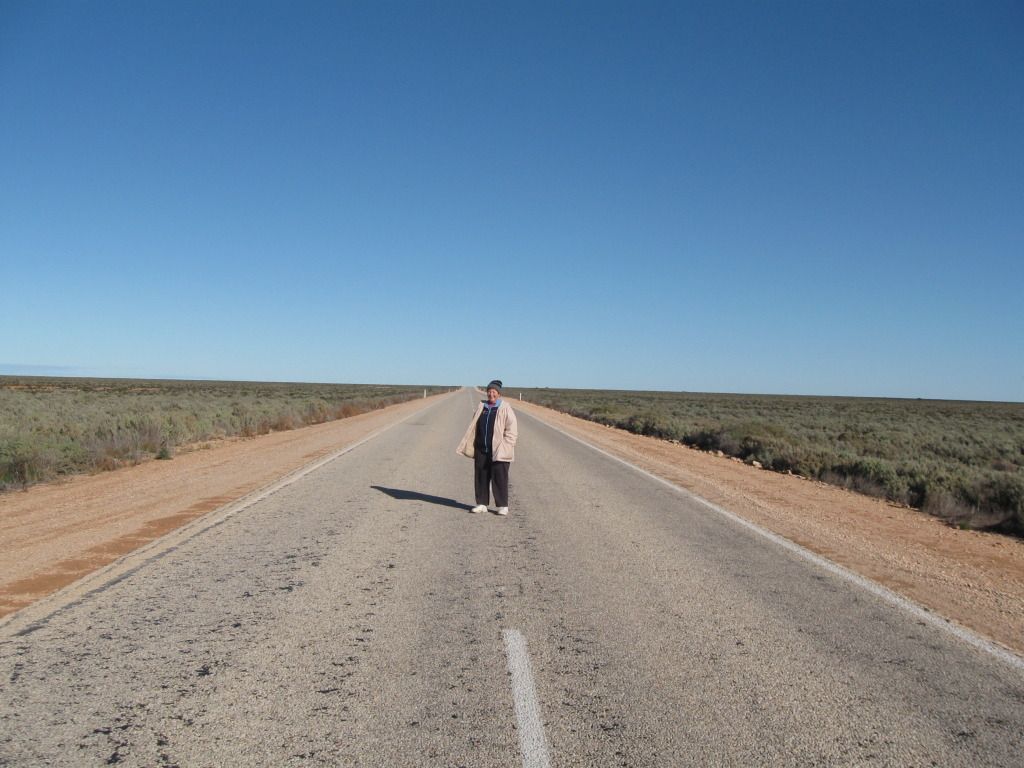
A typical campsite right "on the gold."
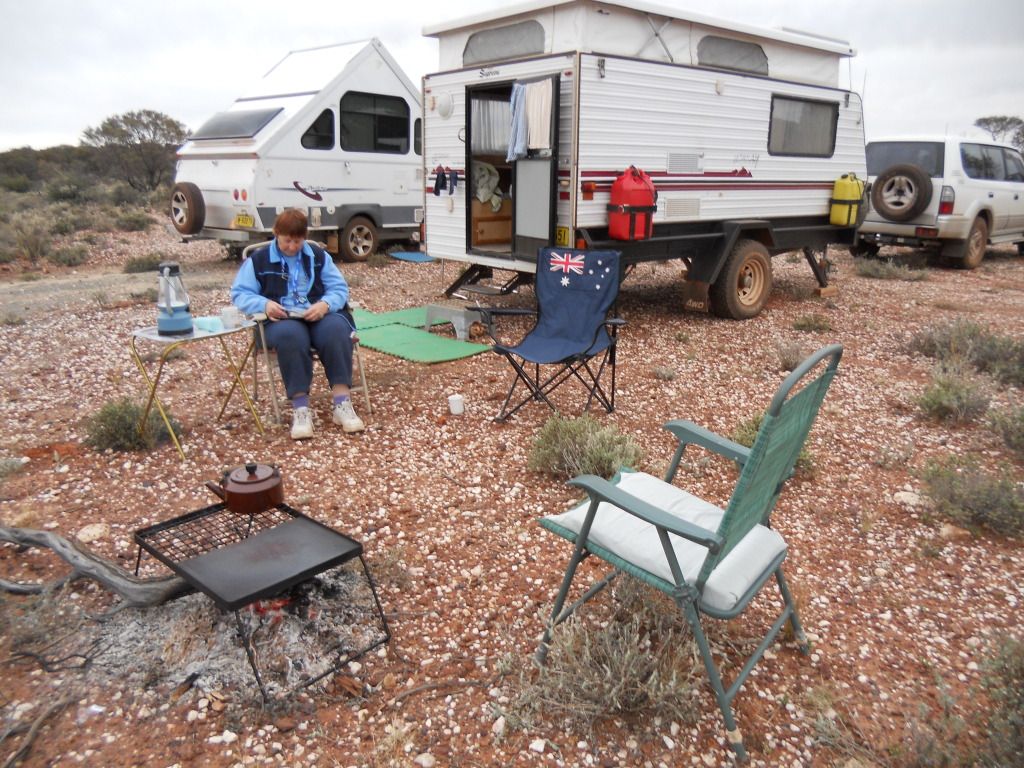
No comment necessary.

This bloke visited us everyday and took no notice of us at all.
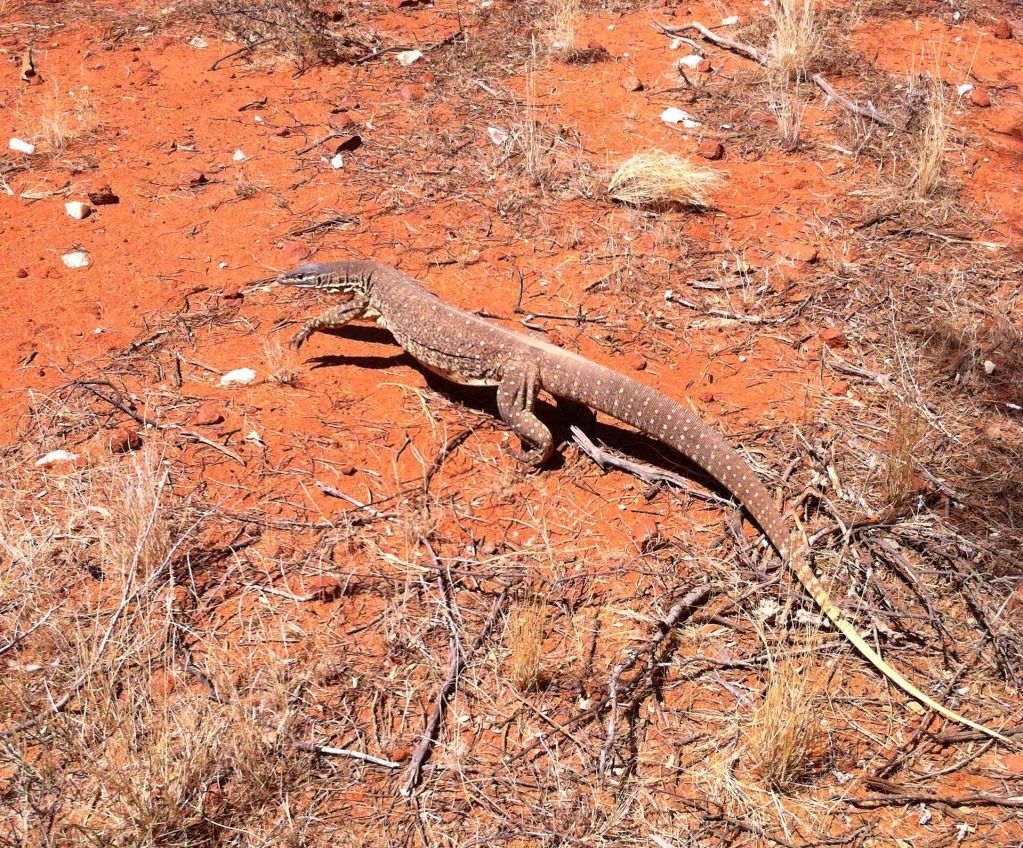
A 24 grammer - the biggest piece on this trip.

Robyn detecting a road
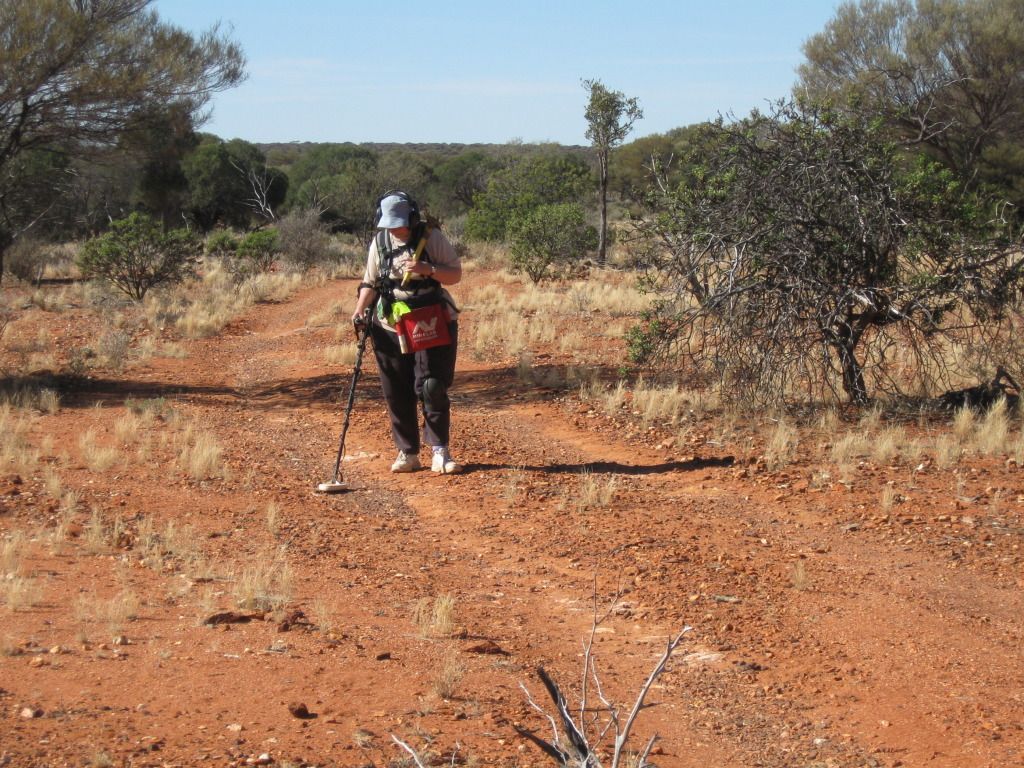
We have seen many lonely and unmarked graves in WA. We imagine that they are all old graves, but are they?
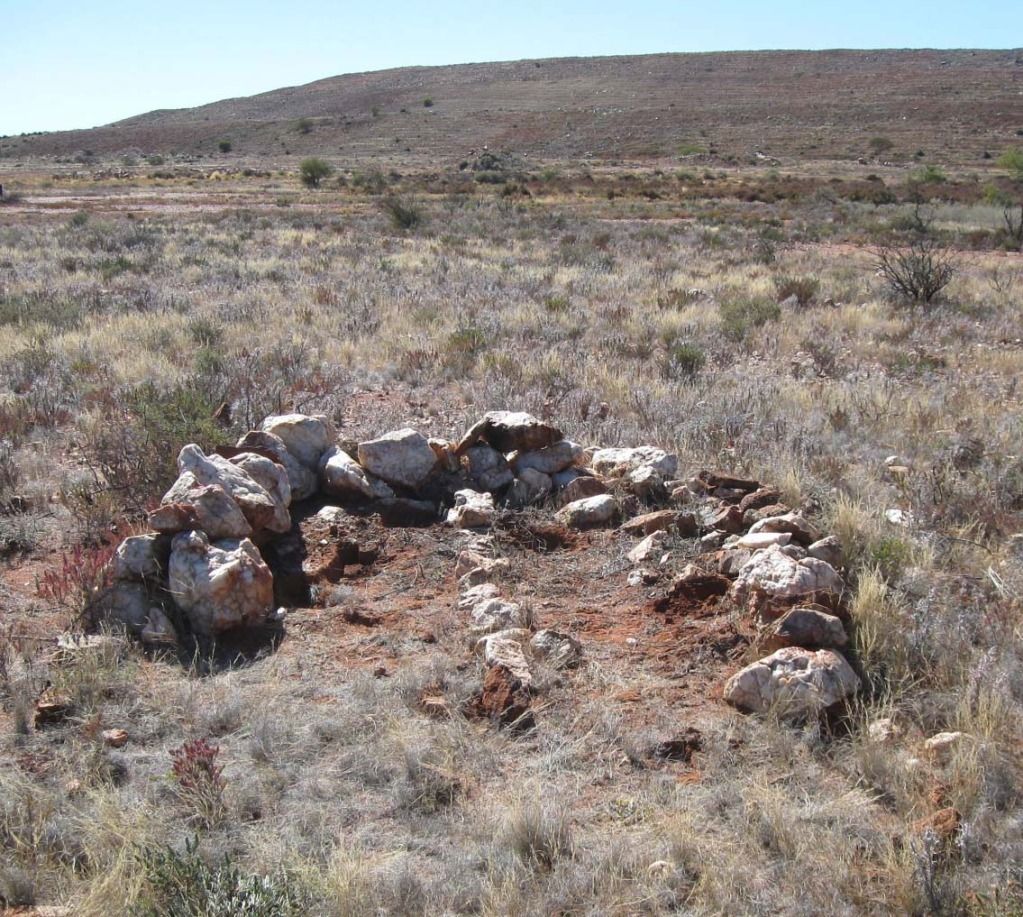
A major crossroad. Every month cars go by here, well most months anyway.
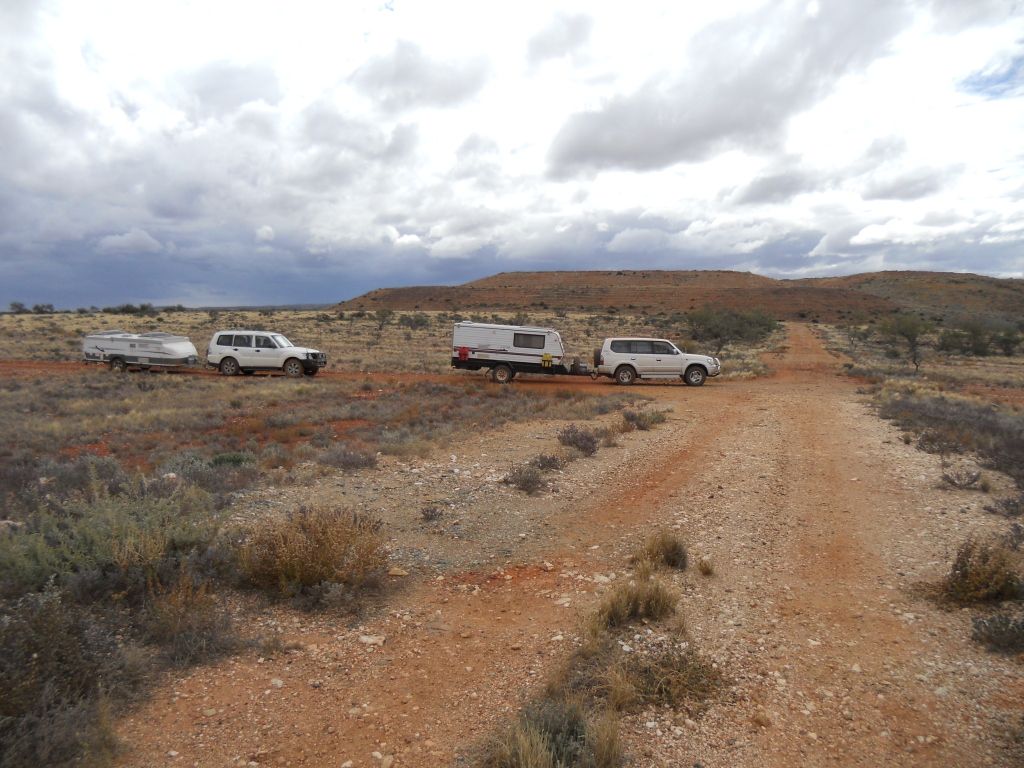
This shows a scraped area. The marks were made by me to show the ground I had detected. I got 61 nuggets from this spot.
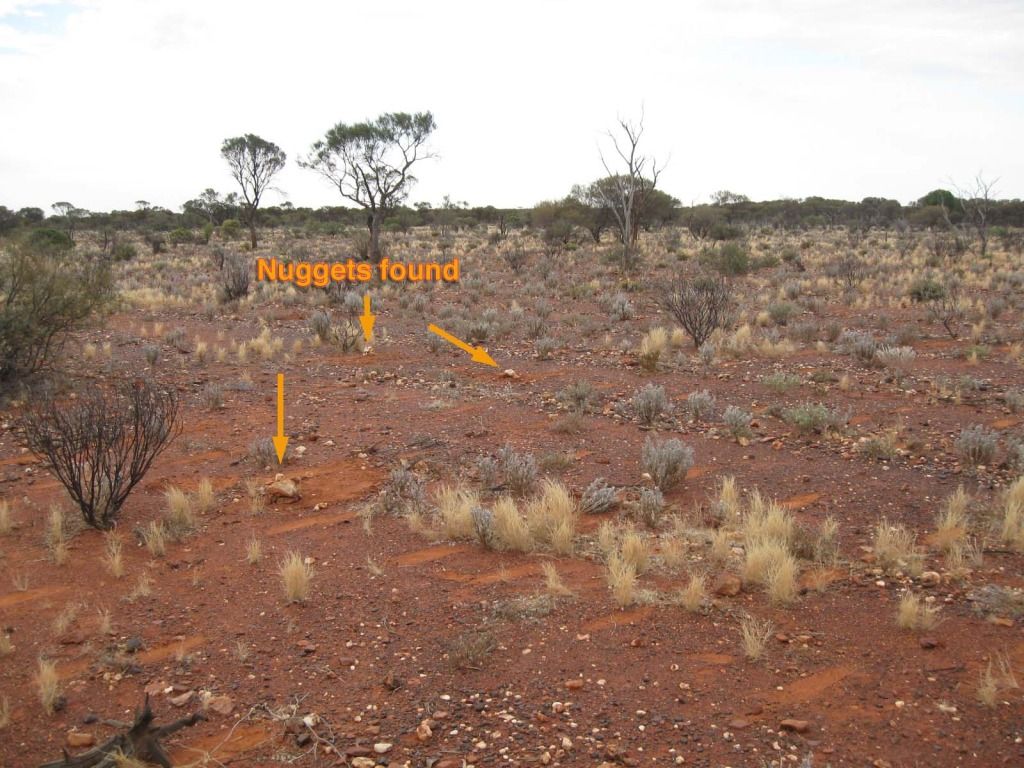
END ____
We headed for Western Australia and, at our rate of travel, it took ten days to get there driving from Sydney across the Nullabor Plain to Kalgoorlie and then another 600kms (360 miles) north from there. It's almost 4000kms (2400 miles) one way. We were looking for somewhere that had not been flogged by thousands of other prospectors with Minelabs.
We couldn't find such a utopian spot, even so far from the well-known areas, and so set out doing the very hard work of detecting seriously flogged sites. We were using Minelab GPX 5000 and GPX 4500. You almost never see other brands on the goldfields in Oz. Our ground is highly mineralised and most brands simply can't cope with it. Minelab are an Australian company and make detectors that really do work in Australian conditions. I cannot comment on their effectiveness elsewhere, but on Australian goldfields they are the detector of choice.
Everywhere we went was "chained". Chaining is done by dragging a heavy chain along to mark a line that shows where you have detected and to enable you to cover all the ground reasonably carefully and without duplication.
We found a great area that had been scraped. Scraping takes the surface off the ground, along with the "not-too-deep" gold, and the scrapings are then processed to remove the gold. Scraped areas are usually rich ground as it is costly to do the scraping. Careful and accurate detecting of a scraped area can be quite profitable as small gold is often left behind.
Many phantom chainers had already been there as the ground was well striped with chain marks, but it was a large area and no one gets all the gold no matter how carefully they work. It took us two weeks to thoroughly cover the place and I came away with 61 small nuggets for 18 grams of gold. (There's roughly 31.1 grams in an ounce.) It was a lot of work for a relatively small return, but without all the care I would have got nought. One man we met later told us that he was at precisely the same spot (before us) and he got nothing at all. He simply did not believe the result I got. My sister-in-law got about 12 grams as well. My wife, after all her recent troubles, was soon forced to stop detecting due to an injury she suffered but she did find a few nuggets before it happened.
Moving on, we came to another area of widely dispersed mine shafts that again had been chained. There was one place well-covered with hundreds of quartz rocks weighing probably about 10 kgs (20lbs) each or more, something like that. It seemed to me that such an area would be not well detected by many, as moving the rocks is quite a task. Bit by bit I shifted them and got just over half an ounce from there in a week or so. The days of easy WA gold is past, but it is still there if you will work for it.
We went to another spot that the old-timers had prospected and once again the phantom chainers had beaten us to it. I decided to prospect along the roadway that is really only a dirt track made by the passage of vehicles over the years. The track was quite compacted by the passing of the 4wd's and the ground was harder than a politicians heart, but not nearly as black.
Straight away I got a few small nuggets and then a 24 grammer (3/4 of an ounce)that was buried about 15 inches down. That signal was a very gentle one at first but soon became quite a screamer. It took a bit of digging, but that one helped me get over an ounce off that track in just a few days.
These places are quite remote and there was little danger of being run-over whilst digging up the road. In fact not one car happened along whilst I was there so you don't need flagmen whilst dong this sort of roadwork.
Some spots we went were relatively non productive, or we were kicked off by mining companies, so I won't bother you with that sort of sad detail.
We were away for over three months and most of the time just camped in the bush. Our caravan and 4x4 are well set up for this sort of travel with serious electrics in the van, solar and a generator and plenty of capacity for water.
We only spent a few nights in caravan parks on the whole trip. That only happened when we went into a town to get food and water, have a shower and do the washing. We had to take all our water with us as there is absolutely nowhere to get water in these rather isolated places. Not everyone is happy doing is sort of thing but we have been doing it all our married lives (almost 48 years) so it suits us well.
Our day began before sunrise when I would be waiting right "on the gold" for enough light to begin detecting. By lunchtime it was too hot to continue and, in any case, we were tired from carrying millions of flies around. So back to the van for lunch and a siesta and returning to the action after 4.00pm. The earliest nugget I found was at 5.29am and the latest just after 8.30pm. Long days, hard work, but fun!
Overall we made quite a nice profit from our trip and had a wonderful time camping right on the gold. The closest nugget we got was found about ten feet from the caravan. One lesson is that the easy days are over and you need to gear yourself up for smaller gold and learn the techniques to capture it, otherwise disappointment awaits.
We met quite a few people who got little or nothing at all, but for the careful prospector who is prepared to work for it, and accept many gram sized (or less) nuggets, then you can do well in areas that have seen a lot of action.
Here are a few pics that hopefully give some sort of "feel" of the adventure.
On The Nullabor Plain.

A typical campsite right "on the gold."

No comment necessary.

This bloke visited us everyday and took no notice of us at all.

A 24 grammer - the biggest piece on this trip.

Robyn detecting a road

We have seen many lonely and unmarked graves in WA. We imagine that they are all old graves, but are they?

A major crossroad. Every month cars go by here, well most months anyway.

This shows a scraped area. The marks were made by me to show the ground I had detected. I got 61 nuggets from this spot.

END ____





